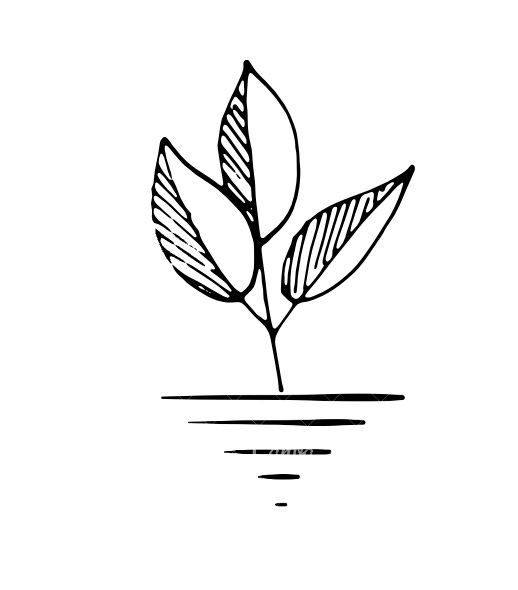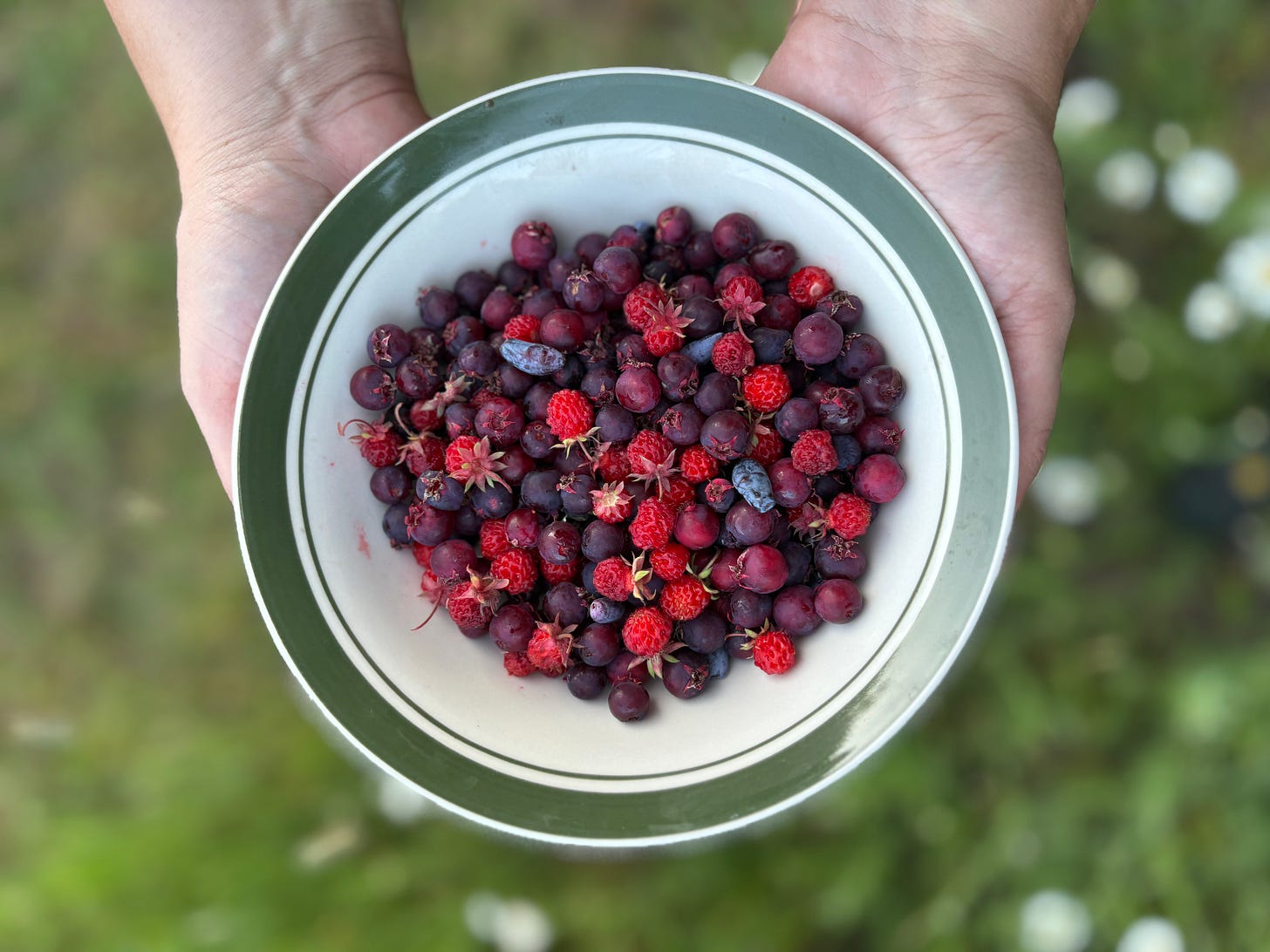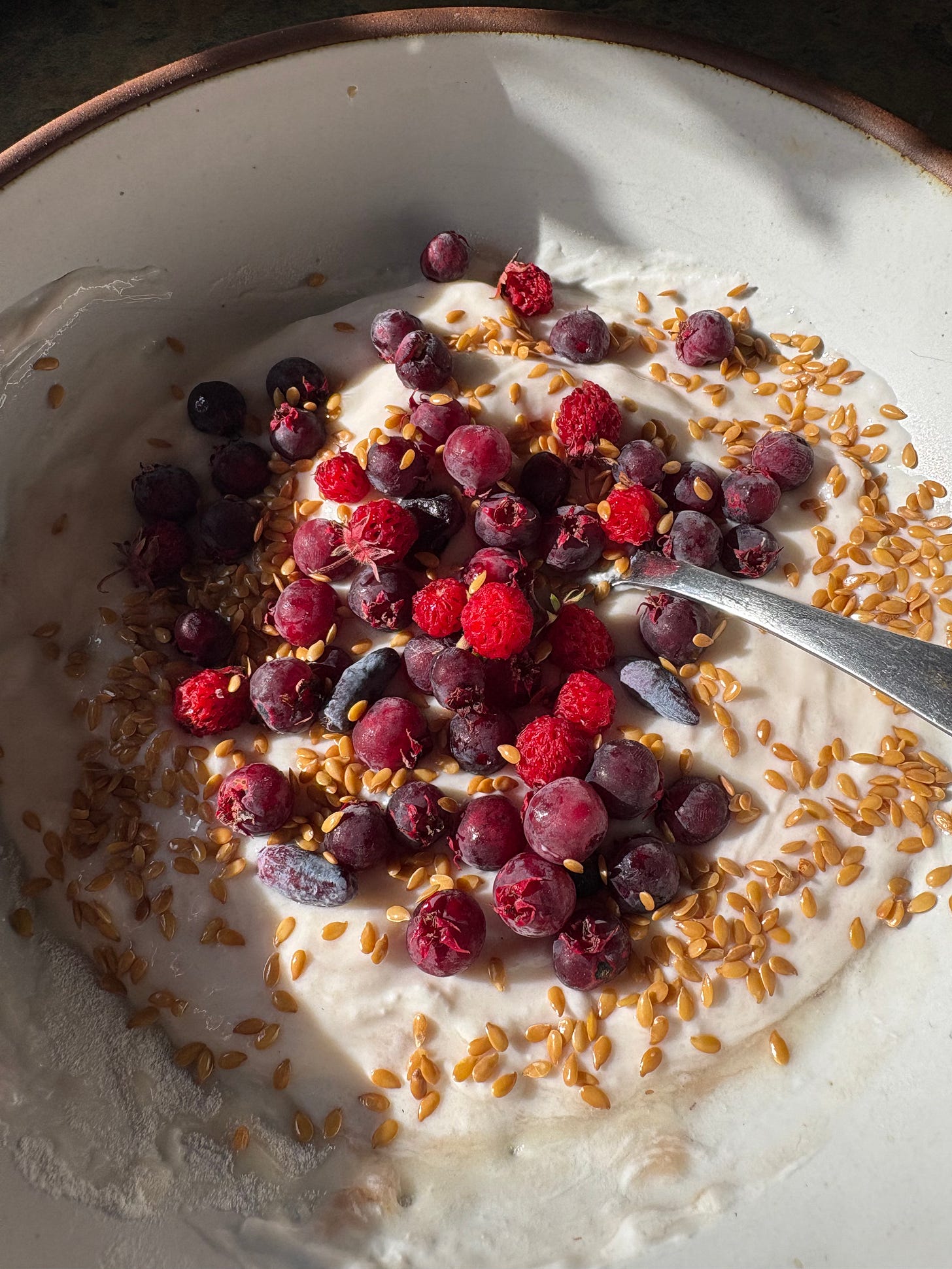Picking Polyphenols
The Science and Soul of Summer’s Sweetest Medicine
Welcome to the Michelle Seguin MD newsletter! If you’re new here, I’m so glad you’ve joined us. Our community continues to grow, and it’s a joy to share this space with you. This week, I’m reflecting on berry season, the science of polyphenols, and what it means to gather with care. Whether you’re foraging in the forest or picking from a nearby farm, this one is for you!
Hello friends,
There’s no other way to put it. July is abundant, especially when it comes to berries. Right now, we’re nearing that fleeting sweet spot when strawberries, raspberries, and blueberries all ripen together. I call it the “triple point” of berry season here in the Keweenaw. But before that peak arrives, there’s a quieter rhythm. A stretch of time when the wild strawberries fade and the serviceberries begin to color the branches.
This week, I’ve been thinking about the meaning of that timing. And how the first berries to ripen often carry something more than just flavor. They carry a message. A gift. I hope you enjoy this one and it inspires you to go picking polyphenols this season.
With gratitude,
Dr. Michelle
Berries as Gifts
The serviceberries ripened in early July this year, just after the last wild strawberries and before the blueberries and raspberries fully came on. That timing felt like a pause in the berry calendar. A quiet bridge between one season and the next. Most years I leave the serviceberries for the birds, but this time, I picked a small bowl. Just enough to bring back to the kitchen and scatter over morning yogurt and a few to freeze for a simmered sauce later this winter.
There’s something about gathering fruit from land, especially when it comes at just the right time. The small act of harvesting felt grounding, maybe even reverent. Not rushed. Not forced. Just received.
I didn’t always think of berries this way. I’ve long loved them for their flavor and health benefits, but a few years ago my understanding shifted. It was the winter of 2018, and I had just emerged from the tender cocoon of early motherhood. Aside from postpartum check-ups, I had mostly stayed close to home, quiet and inward. Still, I signed up for a community seminar. It was something I felt drawn to, even if I couldn’t fully explain why at the time.
The session was called “Land of the Dark Berries’, led by ecologist Karena Schmidt from the Natural Resources Department of the nearby Keweenaw Bay Indian Community. Karena spoke about the more than thirty edible native berries of this region in Upper Michigan, each one woven into traditional ecological knowledge. And she shared the Anishinaabe word for berry—min—which means gift.
That word has stayed with me. Berries are gifts.
She explained how harvesting and sharing berries isn’t just about nourishment. It’s about maintaining relationship with the land, building connection in community, and passing on teachings from one generation to the next. When we pick berries with intention, we are participating in something much older than ourselves.
Since that day, I’ve tried to approach berry season with a bit more reverence. These fruits are more than food. More than antioxidants. They carry stories and memory. They invite us into relationship with place, with tradition, with each other.
The Science of Polyphenols in Practice
Ever since that winter seminar, I’ve been paying closer attention to the science behind what the land already teaches us. Berries are some of the most nutrient-dense fruits we can eat. They are low in sugar, rich in fiber, and filled with polyphenols that help protect and restore the body. I’ve learned a lot from researchers and physicians like Dr. Deanna Minich, Dr. Drew Ramsey, and
, who have helped illuminate how these colorful pigments support the brain, gut, and so much more.A 2024 review in Annual Reviews of Food Science and Technology highlights berries as functional foods with far-reaching effects. Their polyphenols, including anthocyanins, flavonols, and phenolic acids, work together with the gut microbiome to reduce inflammation, support the immune system, and enhance long-term resilience. This is not just about antioxidants. It is about how these compounds interact with our internal ecosystem in ways we are only beginning to fully understand.
Here are five of the most well-supported benefits of regular berry intake:
Supports gut health and microbial diversity - Polyphenols act as prebiotics, encouraging the growth of beneficial bacteria such as Bifidobacteria and Akkermansia, while limiting the growth of potentially harmful species.
Reduces systemic inflammation - Berry polyphenols can reduce inflammatory markers such as IL-6, TNF-alpha, and NF-kB, helping to lower chronic inflammation over time.
Supports cardiovascular health - In a 6 month RCT trial, higher blueberry intake (1 cup per day) has been shown to improve LDL cholesterol, support vascular function, and increase NO (nitric oxide) activity.
Improves blood sugar regulation - Anthocyanins found in berries help moderate post-meal blood glucose spikes and improve insulin sensitivity in both animal and human studies.
Protects brain and cognitive function - Diets rich in berry flavonoids have been associated with slower rates of cognitive decline and improved memory in older adults.
Tip: Even modest amounts of berries can offer meaningful health benefits when eaten consistently. In Brain Health Kitchen, Dr. Annie Fenn recommends at least two half-cup servings or more per week to support cognitive health.
Picking with Purpose
If you’re curious what we’re picking here in Upper Michigan, I’ve included a seasonal snapshot of what we often harvest and observe across our land, garden, and nearby farms. It’s not an exhaustive list, just a reflection of what’s ripening around us this time of year.
Right now, we’re harvesting:
Honeyberries – the earliest of our garden berries, sweet and tart
Wild strawberries – fragrant and fleeting, already beginning to fade
Serviceberries – small, wild, and deeply pigmented, growing along the edges of the clearing
Strawberries – cultivated varieties still producing a second flush at local farms
Soon we’ll be gathering:
Currants – both red and black varieties, tart and vibrant, tucked along hedgerows and garden beds
Wild blueberries – carpeting sunny, acidic hillsides by late July
Raspberries – both red and black varieties, stretching into August
Thimbleberries – soft and delicate, unique to this region and beloved by those who know
High bush blueberries - cultivated varieties from local farms, sweet and abundant in midsummer
Blackberries – ripening in pockets of warmth into late summer
Each berry brings its own flavor, history, and health benefits. But what stays with me most is not just their nutrient profile. It’s the act of gathering. The noticing. The reciprocity. Robin Wall Kimmerer writes about the indigenous practice of “honorable harvest”, a way of relating to the land that centers respect and responsibility.
Never take the first or the last. Take only what you need. Leave enough for others. Harvest in a way that allows the plant to flourish. Use everything you take. Give thanks. Give back.
These principles change the way I move through berry season (& life). I don’t measure the value of the harvest by how much fills my bowl, but by the quiet moments I spend under the trees or in the fields. The careful hands of my son learning to spot (& taste) ripe fruit. The handful left behind for birds (or bears). The whispered thank you as I walk the garden path home.
Robin Wall Kimmerer’s recent book The Serviceberry echoes many of the teachings I first heard in that winter seminar. She writes about reciprocity, gift economies, and the importance of giving back to the systems that nourish us. Her reflections on communal berry picking stayed with me as well. She describes it not only as a seasonal ritual, but as a kind of medicine for the loneliness so many feel today.
I’ve noticed that, too.
Each summer for the past decade, our family visits a local farm to pick high-bush blueberries. The aisles are wide enough for strollers, wagons, and wheeled walkers, and you often see families spread out across generations. There’s conversation, laughter, and the quiet rhythm of hands moving through branches and the tink, tink of berries dropping into buckets. It always makes me smile. In a world that can feel rushed and fragmented, berry picking offers something different. A chance to remember that nourishment is often meant to be shared.

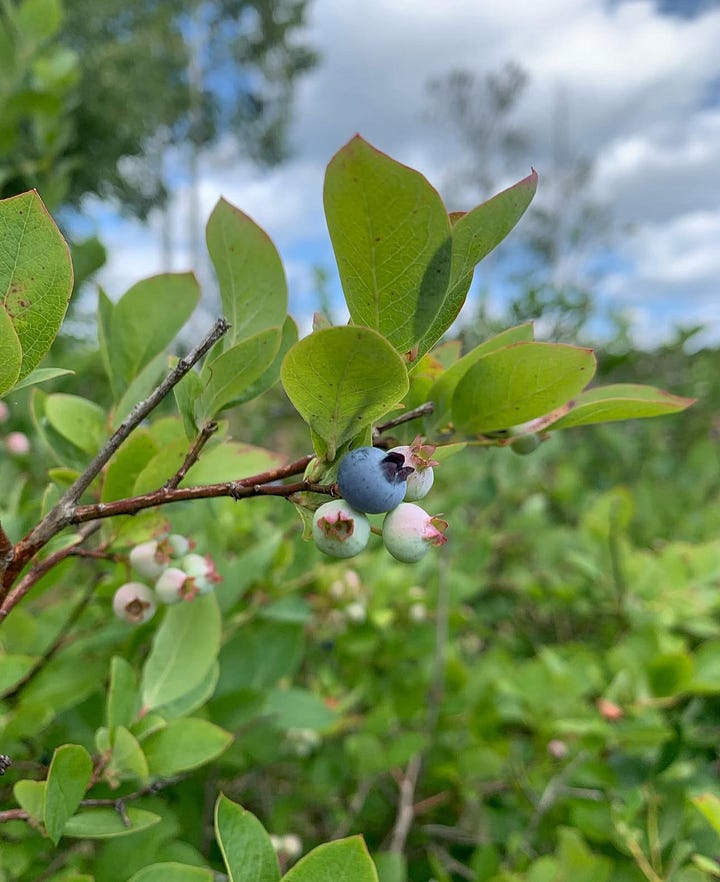
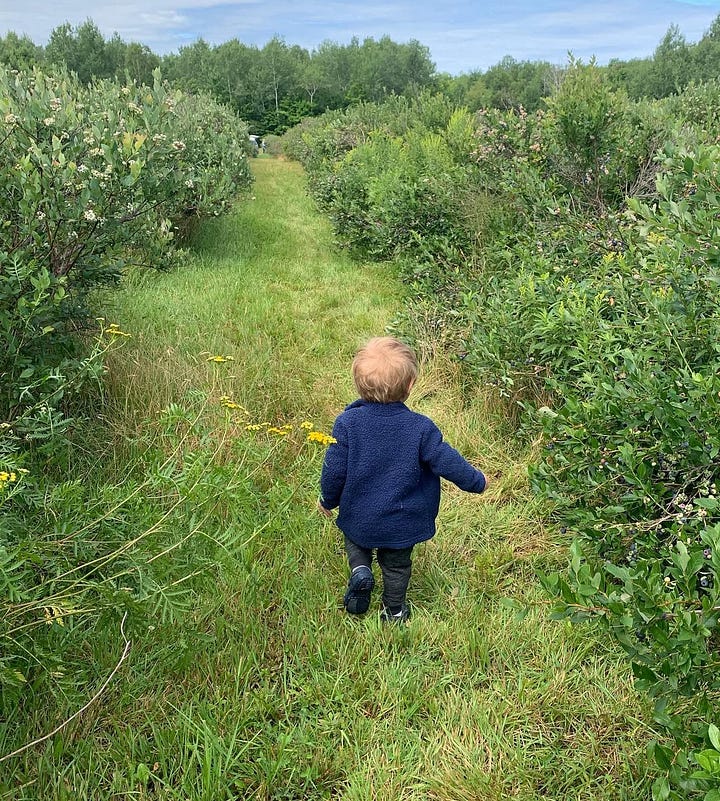

1. Berry Triple Point (wild blueberries, raspberries, strawberries). 2. High-bush blueberries. 3. Throw back to my son wandering the aisles of the blueberry farm 4. Picking polyphenols - learning ripeness by feel
I’d love to hear what berries you’re picking this season. Do you have a favorite patch or a family tradition? Tell me what’s ripening in your corner of the world. I always love reading your stories.
In Closing
Whether you’re foraging along the forest edge or picking berries from a local farm, this is a beautiful time to bring them into your rhythm.
If you're gathering from the wild, look for sun-warmed hillsides and shrubby edges in the morning hours. Taste first, harvest lightly, and always leave some behind. Be sure to confirm your identification from a trusted source, especially if you’re new to foraging. When in doubt, let it be.
If you’re heading to a u-pick farm, go early, wear a wide-brimmed hat, and take your time. I always love the quiet shuffle of feet between the rows, the buzz of bees nearby, the way children learn to spot ripeness by feel. And if your berries come frozen from the co-op or tucked into a container at a roadside stand, that counts too.
For now, I invite you to pick a handful. Eat them slowly. Let them stain your fingers and rest on your tongue. Give thanks. And remember that nourishment is not just what we take in, but how we take part.
With love and care,
Dr. Michelle
Physician, Gardener, Home Cook, and Forever Curious
P.S. If something here resonated, I’d be honored if you gave it a like or shared it with a friend. This space continues to grow into a community rooted in seasonal rhythms, good food, and thoughtful connection.
Here are my most recent Substack sharings:


